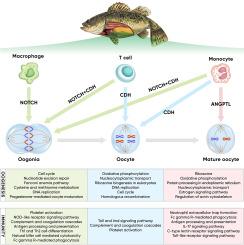Single-cell atlas of the mandarin fish ovary reveals the trajectories of oogenesis and its immune microenvironment development
IF 3.9
1区 农林科学
Q1 FISHERIES
引用次数: 0
Abstract
The establishment of the immune microenvironment during oogenesis in teleosts plays a critical role in individual resistance to disease and consequently on population dynamics. However, the maternal influence on offspring immunity is poorly understood, particularly regarding the dynamic development and underlying mechanisms of the oocyte immune microenvironment. Here, we characterized the single-cell atlas of the mandarin fish (Siniperca chuatsi) ovary at late stage IV and identified three types of germ cells and five types of somatic cells. The distinctive features of the three germ cell types were further explored through enrichment analysis, suggesting that the immune microenvironment of fish oocytes is formed during the mature oocyte stage. Subsequently, based on the pseudotemporal analysis of these three germ cells, as well as clustering analysis and cell-cell communication analysis, we characterized the trajectories of oogenesis and formation of its immune microenvironment in the mandarin fish ovary. Notably, we identified a high-low-high expression pattern in immune-related pathways across different development stages of oocytes. Furthermore, the spatiotemporal expression dynamics of six key markers were validated using RNA-FISH. These findings provide novel insights into oogenesis and the establishment of maternal/innate immunity in teleost fishes.

鳜鱼卵巢单细胞图谱揭示了卵发生及其免疫微环境发育的轨迹
硬骨鱼卵形成过程中免疫微环境的建立对个体抗病以及种群动态起着至关重要的作用。然而,母体对后代免疫的影响知之甚少,特别是关于卵母细胞免疫微环境的动态发育和潜在机制。本文对鳜鱼卵巢4期晚期的单细胞图谱进行了研究,鉴定出3种生殖细胞和5种体细胞。通过富集分析进一步探索了三种生殖细胞类型的不同特征,提示鱼卵母细胞的免疫微环境是在卵母细胞成熟阶段形成的。随后,基于这三个生殖细胞的伪时间分析,以及聚类分析和细胞间通讯分析,我们表征了鳜鱼卵巢中卵发生及其免疫微环境的形成轨迹。值得注意的是,我们在卵母细胞的不同发育阶段确定了免疫相关途径的高-低-高表达模式。此外,利用RNA-FISH验证了6个关键标记的时空表达动态。这些发现为硬骨鱼的卵发生和母体/先天免疫的建立提供了新的见解。
本文章由计算机程序翻译,如有差异,请以英文原文为准。
求助全文
约1分钟内获得全文
求助全文
来源期刊

Aquaculture
农林科学-海洋与淡水生物学
CiteScore
8.60
自引率
17.80%
发文量
1246
审稿时长
56 days
期刊介绍:
Aquaculture is an international journal for the exploration, improvement and management of all freshwater and marine food resources. It publishes novel and innovative research of world-wide interest on farming of aquatic organisms, which includes finfish, mollusks, crustaceans and aquatic plants for human consumption. Research on ornamentals is not a focus of the Journal. Aquaculture only publishes papers with a clear relevance to improving aquaculture practices or a potential application.
 求助内容:
求助内容: 应助结果提醒方式:
应助结果提醒方式:


